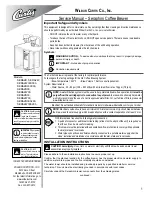
58 •
Fieldbus coupler/controller
Fieldbus coupler 750-319
L
ON
W
ORKS
®
Example: the 13
th
I/O module is removed.
1.
The "I/O" LED generates a fault display with the first blink sequence (approx. 10 Hz).
2.
The first pause is followed by the second blink sequence (approx. 1 Hz). The "I/O"
LED blinks four times and thus signals the fault code 4 (internal bus data fault).
3.
The third blink sequence follows the second pause. The "I/O" LED blinks twelve
times. The fault argument 12 means that the internal bus is interrupted after the 12th
I/O module.
3.1.7.5 Supply voltage status
There are two green LEDs in the coupler supply section to display the supply
voltage. The left LED (A) indicates the 24 V supply for the coupler. The right
hand LED (C) signals the supply to the field side, i.e. the power jumper con-
tacts.
LED
Color
Meaning
A
green
Status of the operating voltage – system
C
green
Status of the operating voltage – power jumper contacts
3.1.8 Fault behavior
3.1.8.1 Fieldbus failure
A fieldbus failure is given i. e. when the network manager (PC with Network
Management Tool Software) cuts-out or the bus cable is interrupted. A fault in
the network manager can also lead to a fieldbus failure.
For the LON fieldbus coupler the fault code and the fault argument are trans-
fered by network variables or explicite messages.
3.1.8.2 Internal bus fault
An internal bus fault is created, for example, if an I/O module is removed. If
this fault occurs during operation, the output modules behave in the same
manner as an I/O module stop.
The "I/O" LED blinks red.
The coupler generates a fault message (fault code and fault argument).
Once the internal bus fault is fixed, the controller starts up following power
being cycled as during a normal start-up. The transfer of the process data is
then resumed and the node outputs are correspondingly set.
















































